|
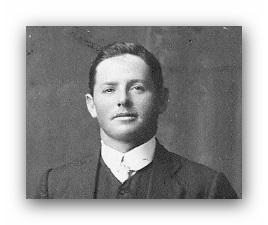
Alex was the 3rd oldest surviving in the family of 11 of whom 8 lived to adulthood.
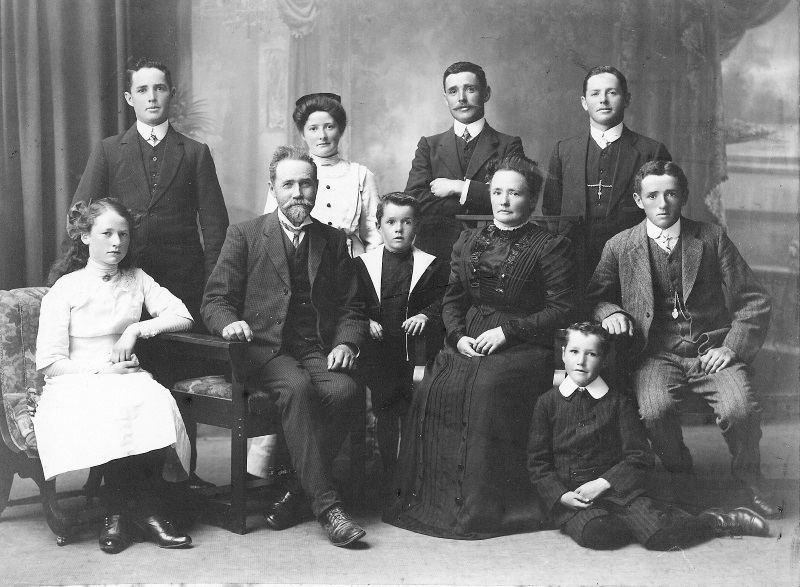
12th Otago Mounted Rifles territorials, circa 1912, from the Waikaka Valley/Maitland area .These
men were part time soldiers before the war, many were farmers. Some went to the war early and some
later depending on their circumstances. Some would have been married with children and a farm to
run, so getting away at the first instance was not practical .Some were to never
return.
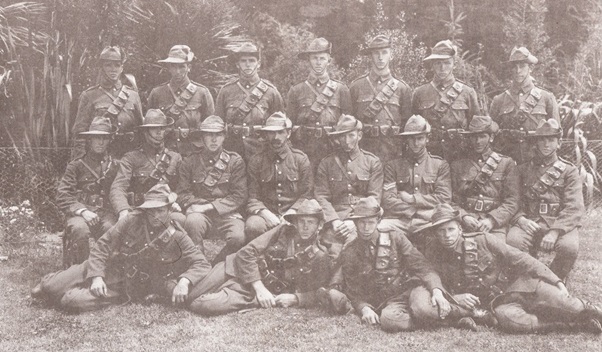
Standing
,back row left to right
1.Albert George Johnston ,32674,Farmer from Maitland ,Killed in Action on the 12th of October
1917.
2.Possibly James Cumming 8/339,Labourer from Fairfax ,N.O.K Riverton
3.Charles Haddon Spurgeon Johnston ,13/2982,Farmer from Merino Downs.
4.Hugh Pearson McIntyre ,9/1626,Farmer from Maitland .
5.William Thomas Nichol,9/1934,Farmer from Maitland .
6.Robert Nichol,32713,Farmer from Maitland.
7.William Chittock,39165,Self employed Farmer from Waikaka Valley.
Middle Row
1.Stewart Alexander Aitken ,9/108,Farmer from Waikaka Valley,Killed in Action on the 29th of April
1918.
2.Samuel Paterson,9/188,A Farmer from Waikaka.
3.John Taylor,9/217,Saddler from Milton.
4.John Sheddan ,9/207a,Groom from Clinton ,N.O.K Waikaka Valley .
5.Possibly Henry Frederick Chittock ,78428,Railway Porter from Greymouth ,Born in Gore
.
6.Robert
Cumming ,54122,Farmer from Waikaka Valley .
7.Alex Byars Johnston ,12552,Farmer from Hiwaroa,N.O.K Comly Bank,Gore .Awared the Military Cross
.
Front.
1.Possibly Robert Hugh McPhail,23595,Farmer from Waikaka Valley ,Killed in Action ,2nd of September
1918.
2.Adam Rankin Johnston ,53365,Farmer from Waikaka Valley.
3.William McIntrye ,9/165,Farm Labourer from Maitland ,Killed in Action on the 15th of September
1916.
4.John Oliver McPhail ,Farmer from Waikaka Valley,87370.
The original photo is in the West Otago museum ,Tapanui
.
Alec Johnston left for World War 1 from Balfor with his horse where he was farming with older
brother John at "Glen Gordon."
His duty commenced on 9th July 1915
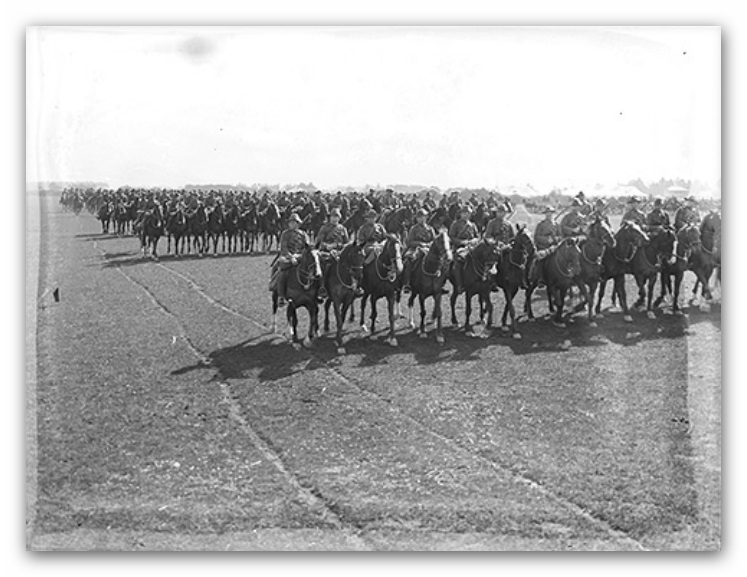
The Canterbury Mounted Regiment marching past during an inspection at Sockburn
Camp.
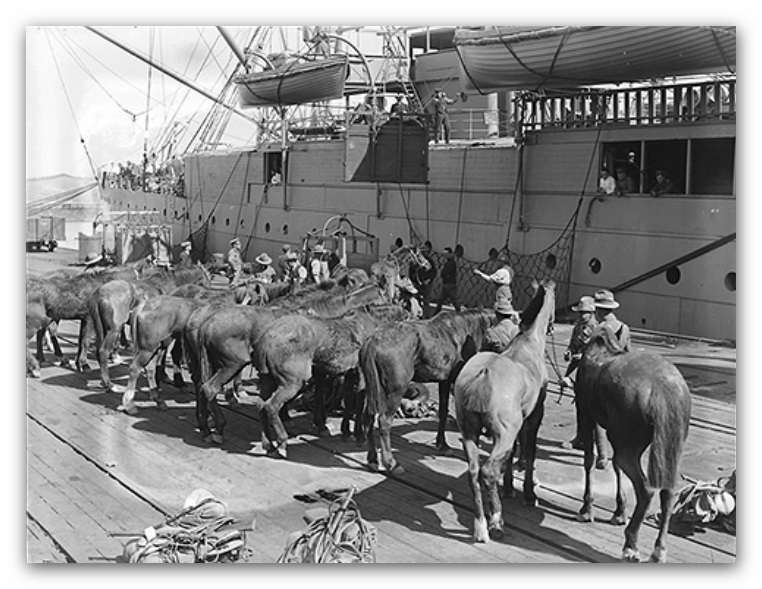
Loading Canterbury Mounted Rifles horses at Lyttelton
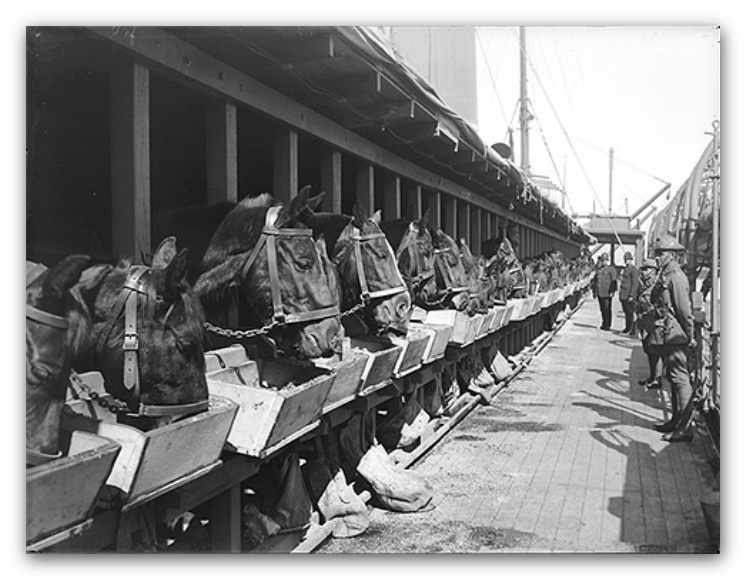
The horse stalls on board the transport ship.
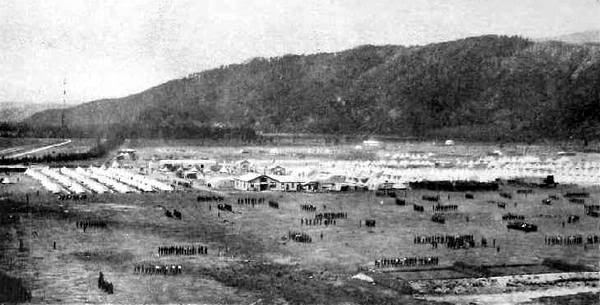
Trentham Camp 1915
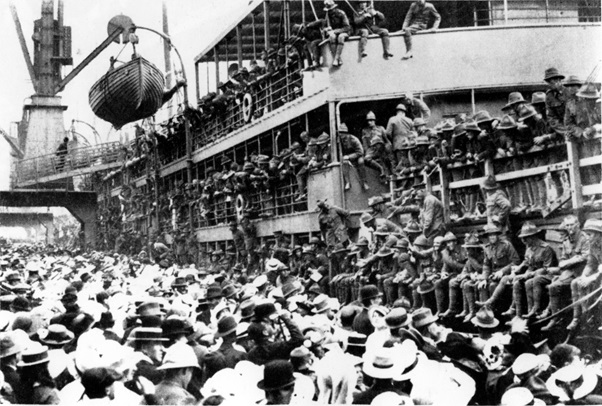
Typical sceen when troups embarking at Wellington
|
The ships crossed the globe,
sailing by way of Wellington, Hobart, Albany, Colombo, Aden and finally arriving in
Alexandria to disembark.
Although the troops were disappointed at leaving the
ships in Egypt, as they thought the posting would mean only isolated garrison duty
- a duty well distant from the war in Europe, the relief for the horses to be again
on dry land was evident for all to see, after the first wobbly steps the horses
could not be restrained from rolling in the sand, kicking up their heels or
breaking free in sheer delight at being out of their restricting
stalls.
|
|
|
The Turkish Ottoman Empire
entered the war on the side of Germany. The New Zealand and Australian Forces were
directed to Egypt to defend the Suez Canal.
From April 1915 the Infantry and Artillery departed
Egypt to attack the Turkish mainland on the Gallipoli peninsular. The combined
British, French and the New Zealand - Australian division's attack found themselves
unable to dislodge the capable Turkish defenses. Within three weeks the Canterbury
Mounted Rifles along with the rest of the Brigade found themselves fully committed
in the Dardenelles, fighting not as mounted riflemen but as Infantry. There was no
opportunity to utilise horses on the precarious hills of Gallipoli at
ANZAC.
After the retreat from the Dardenelles in December
1915 the regiment withdrew back to Cairo, and early in the following year began the
Campaigns in the desert of Sinai and Turkish Palestine. This second campaign was a
much different scenario to the Gallipoli failure. Men and horses of the NZMR proved
a much more capable fighting force in the open desert and plains of the Holy Lands.
A long two year campaign that only finished with the surrender of Turkish forces in
October 1918.
|
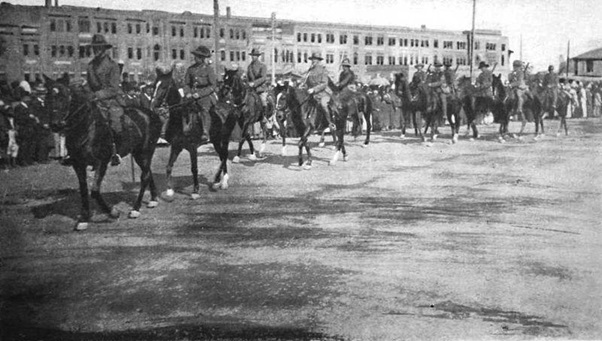
Regimental Headquarters on the march through Cairo
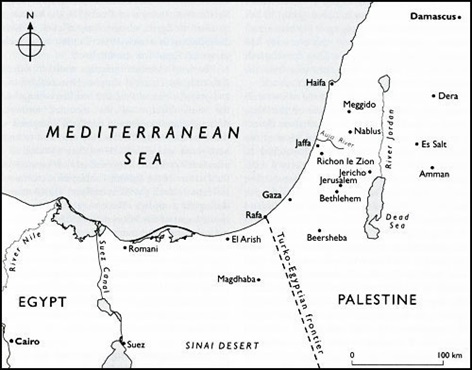
Map Sinai/Palestine 1916-18
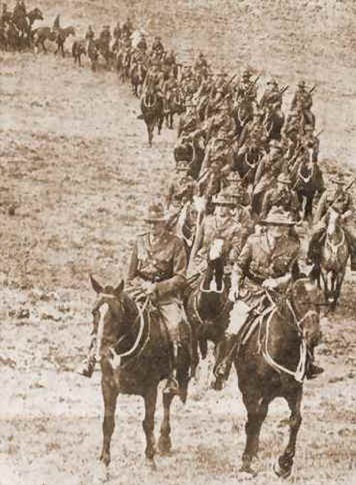
NZMR Middle East

Troops of the ANZAC Mounted Division and their horses on the beach at
Marakeb.. Powles family :Photographs. Ref: 1/2-178892-F. Alexander Turnbull Library,
Wellington, New Zealand. http://natlib.govt.nz/records/23206310
Battle of Magdhaba
It had been a race against darkness and water, for if Magdhaba had not fallen
there was no water nearer than El Arish, and if darkness had fallen before the
trenches were captured most of the Turks would have got away.
One of the decisive events of the afternoon was the capture of a battery of
four mountain guns by Lieutenant A. B. Johnston, with his troop of the 8th
Squadron. This battery had given much trouble and was still firing when
Johnstone with six men rushed the emplacement, and the garrison consisting
of 2 officers and 15 men surrendered. Casualties were light in spite of the
prolonged nature of the fighting; among those who fell was Lieutenant H. A.
Bowron, of the 10th Squadron, who was hit during the early advance over the
bare plain.
MIILITARY DECORATIONS
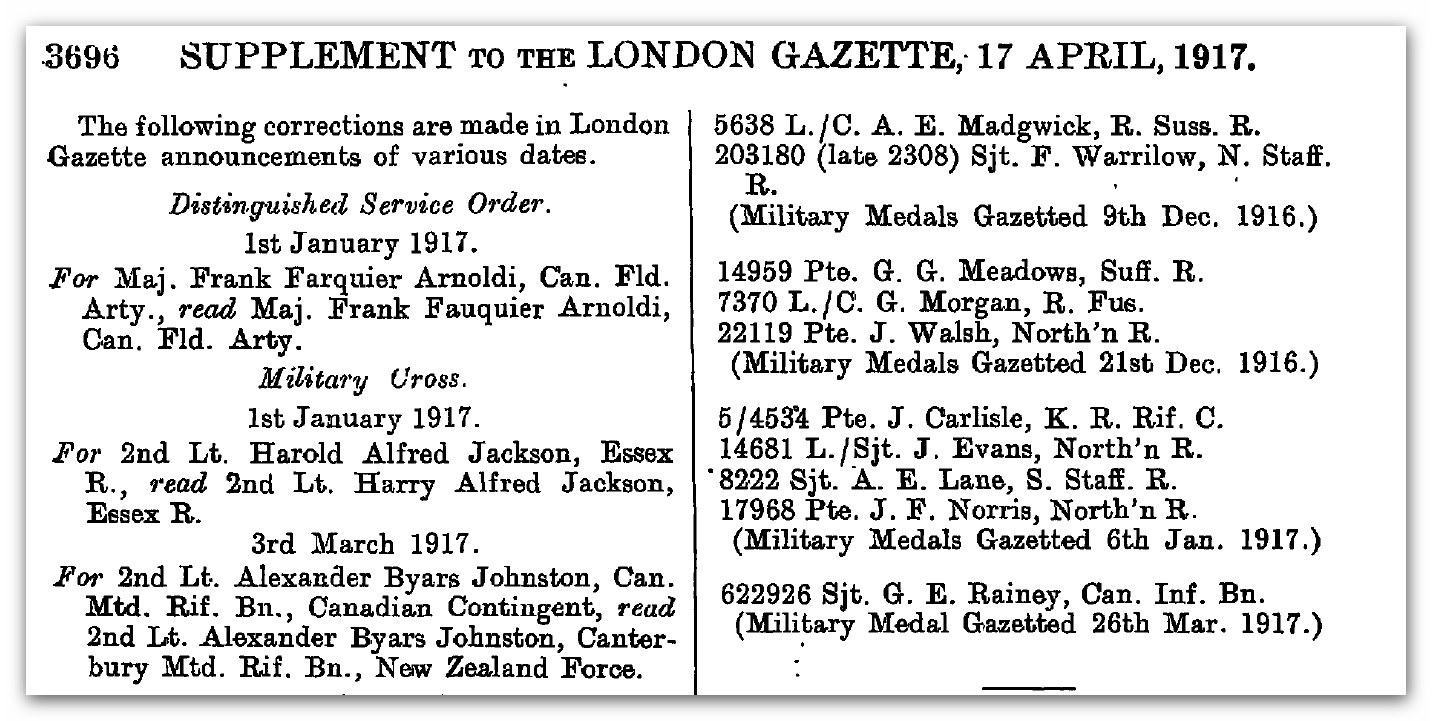

View of the hill of Tel el Saba (Tell es Sabe) just after capture by the
British Army. Powles family :Photographs. Ref: PA1-q-605-23-4. Alexander Turnbull Library,
Wellington, New Zealand. http://natlib.govt.nz/records/23023566

Powles, Charles Guy (Colonel), 1872-1951. Tel el Saba (Tell es Sabe)
immediately after capture. Powles family :Photographs. Ref: PA1-q-605-23a-7. Alexander
Turnbull Library, Wellington, New Zealand. http://natlib.govt.nz/records/23231956
http://anzacportal.dva.gov.au/history/publications/australians-world-war-i-australian-light-horse-%E2%80%93-palestine-1916-1918/chapter-7
On the night of 30
October 1917, British infantry and Anzac and British mounted troops marched through the dark
towards Beersheba. At dawn the British 53rd, 60th and 74th Divisions, supported by an artillery
bombardment, attacked a 5-kilometre line of entrenched positions. They seized the outer defences
of Beersheba shortly after noon. The Anzac Mounted Division swept around the south-east and east
of Beersheba and the 2nd Light Horse Brigade seized the Hebron road to the north of the town.
The infantry attack did not succeed in drawing sufficient Turkish forces to the western
defences, and the hill of Tel el Saba on the eastern side of the town continued to be strongly
held. The men of the ANZAC Mounted Division, attacking on foot with the support of British
artillery, made slow progress and it was not until 3 pm that the Anzacs were close enough to
seize the hill.
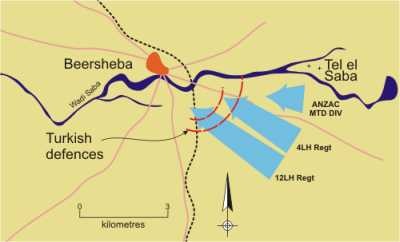 MORE MORE
With time running out for the
Australians to capture Beersheba and its wells before dark, Chauvel ordered Brigadier General
William Grant, commanding the 4th Light Horse Brigade, to make a mounted attack directly towards
the town. Chauvel knew, from aerial photographs, that the Turkish trenches in front of the town
were not protected by barbed wire. However, German bombing had forced the 4th Brigade into a
scattered formation and it was not until 4.50 pm that they were in position. The brigade
assembled behind rising ground 6 kilometres south-east of Beersheba with the 4th Light Horse
Regiment on the right, the 12th Light Horse Regiment on the left and the 11th Light Horse
Regiment in reserve.
The Australian Light Horse was
to be used purely as cavalry for the first time. Although they were not equipped with cavalry
sabres, the Turks who faced the long bayonets held by the Australians did not consider there was
much difference between a charge by cavalry and a charge by mounted infantry. The light horse
moved off at the trot, and almost at once quickened to a gallop. As they came over the top of
the ridge and looked down the long, gentle open slope to Beersheba, they were seen by the
Turkish gunners, who opened fire with shrapnel. But the pace was too fast for the gunners. After
3 kilometres Turkish machine-guns opened fire from the flank, but they were detected and
silenced by British artillery. The rifle fire from the Turkish trenches was wild and high as the
light horse approached. The front trench and the main trench were jumped and some men dismounted
and then attacked the Turks with rifles and bayonets from the rear. Some galloped ahead to seize
the rear trenches, while other squadrons galloped straight into
Beersheba.
Nearly all the wells of
Beersheba were intact and further water was available from a storm that had filled the pools.
The 4th and 12th Light Horse casualties were thirty-one killed and thirty-six wounded; they
captured over 700 men. Among the many gallant acts that day were the actions of Staff Sergeant
Arthur Cox, who single-handedly under very heavy fire captured a machine-gun and crew of five in
a redoubt; and those of Trooper Sloan Bolton, who assisted in the capture of a field gun, an
officer and seven other ranks. Both were members of the 4th Light Horse Regiment, and both were
awarded the Distinguished Conduct Medal.
The capture of Beersheba meant
that the whole Turkish line was turned. However, among the Australian casualties that day was
Lieutenant Colonel Leslie Maygar VC, Commander of the 8th Light Horse Regiment since 1915, who
had been awarded the Victoria Cross in South Africa in 1901. After reporting to Chauvel’s
headquarters, Maygar had just returned to his unit when he was wounded by an attacking German
aircraft. Maygar’s horse bolted with him into the night and by the time he was found he had lost
a lot of blood. He was taken to hospital at Karm, but died the next day. He was buried at
Beersheba War Cemetery, which is now in Israel.
The mounted troops and British infantry followed up the victory, thrusting
into the steep hills of southern Palestine. On the flank of the mounted troops a detachment
of Arabs under Lieutenant Colonel Stewart Newcombe, a British engineer who had been attached
to the Australians in Gallipoli and France, pressed ahead on the extreme right towards
Hebron. This, with the activity of the 2nd Light Horse Brigade, caused the Turks to withdraw
reserves from Gaza to protect Hebron. On the night of 1 November, the 52nd, 54th and 75th
British divisions of the XXI Corps struck between Gaza and the sea and outflanked the town.
Meanwhile the Desert Mounted Corps was stopped at Tel el Khuweilfe, and for a week this area
was the scene of tense fighting, until the hill was seized by the 53rd Division on 8
November, the day after Gaza was captured by XXI Corps.
VIDEO - BATTLE FOR BEERSHABA
31-10-1917

General Chaytor receiving the KCMG, Jerusalem. Powles family :Photographs.
Ref: PA1-q-605-44-4. Alexander Turnbull Library, Wellington, New
Zealand. http://natlib.govt.nz/records/23078707
At some point Alex met up with T.E. Lawrence (Lawrence of Arabia)
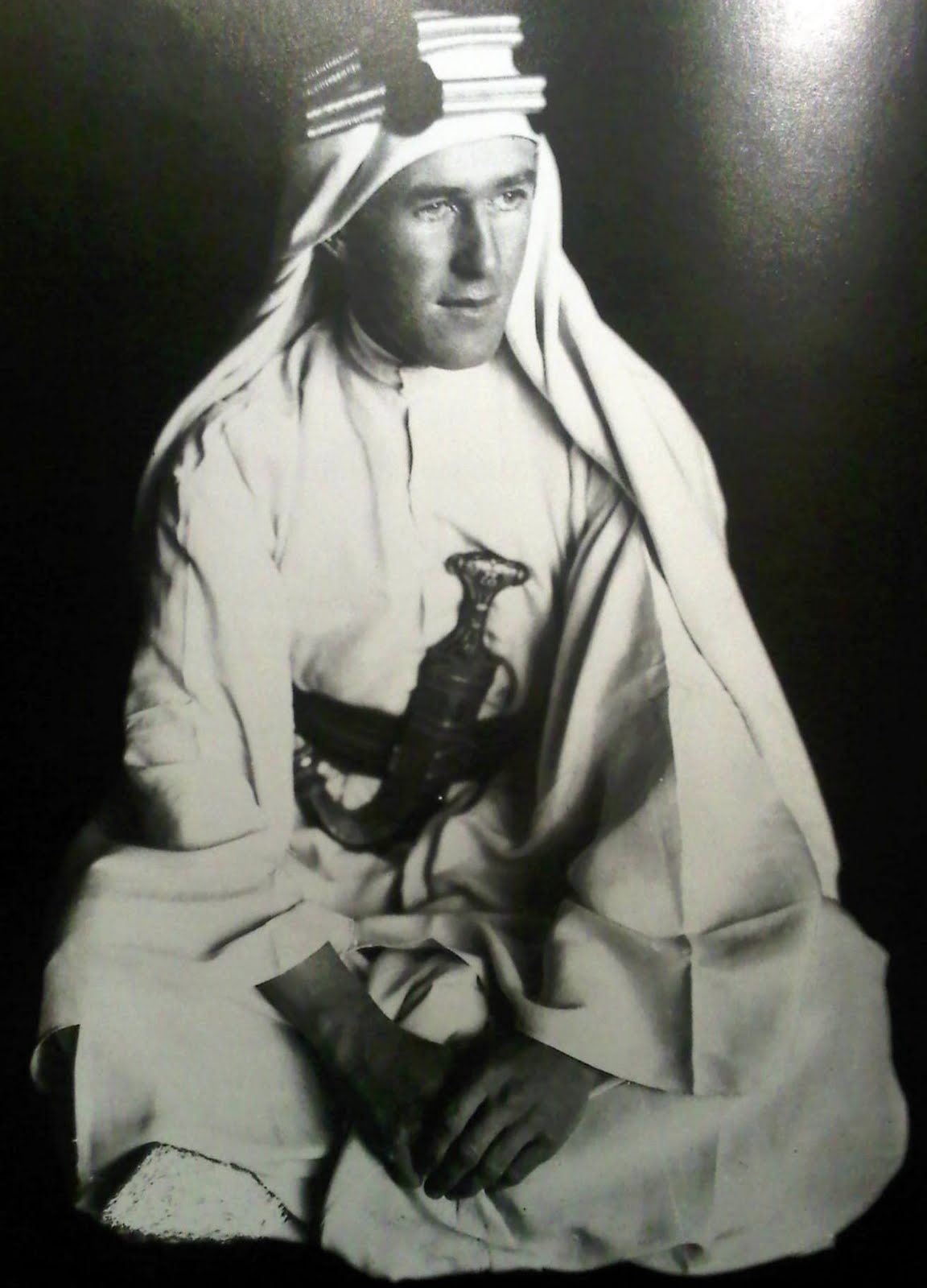
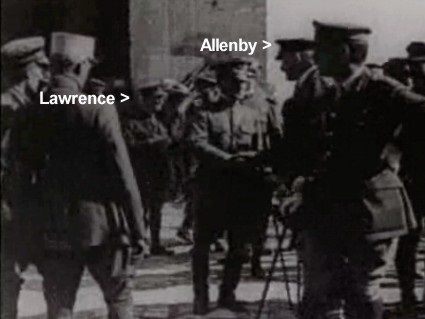
http://www.jpost.com/Christian-News/TE-Lawrence-wanted-to-see-Jewish-colonies-bright-spots-in-a-desert-in-the-Holy-Land-473862
https://www.cliohistory.org/thomas-lawrence/
"A lot of the men came from
the country, and they were farmers, and they knew how to shoot rabbits and live close to the
land. They made good soldiers." said L. Watt, National Army Museum,
2016.
Why should the horses from New
Zealand and Australia stand the rigors of a campaign so well?
The horse is bred and reared in an ideal climate. During his early days he lives a natural outdoor
life. The horses imported into Australasia were by no means the best. Other countries imported more
valuable and better bred horses; the foundation stock in Australia and New Zealand could very
easily be classed as only of medium quality. The best bred sires in New Zealand and Australia are
used for the breeding of racing stock. The sires used on the stations are horses that have been
sold as unsuitable for racing; their breeding may be good or indifferent. Therefore, it is the
racing which keeps the standard high. Every year there are numbers of yearlings and two-year-olds
that have met with injuries or accidents which tender them useless as racehorses; these are the
class which find their way into the stations and are used as sires on good class mares. This is
where the New Zealand and Australian remount comes from. A fixed breed has been imported into
countries which have a climate and environment where the horse does not deteriorate, but improves.
New Zealanders are a horse-loving people; they are sportsmen to the core. The horses that have
stood the campaign the best are low-set, well balanced horses. Remounts should show breeding.
Well-built ponies from 14.1 to 14.3 hands, with good, straight, clean action, have withstood the
rigours of the campaign much better than taller horses.
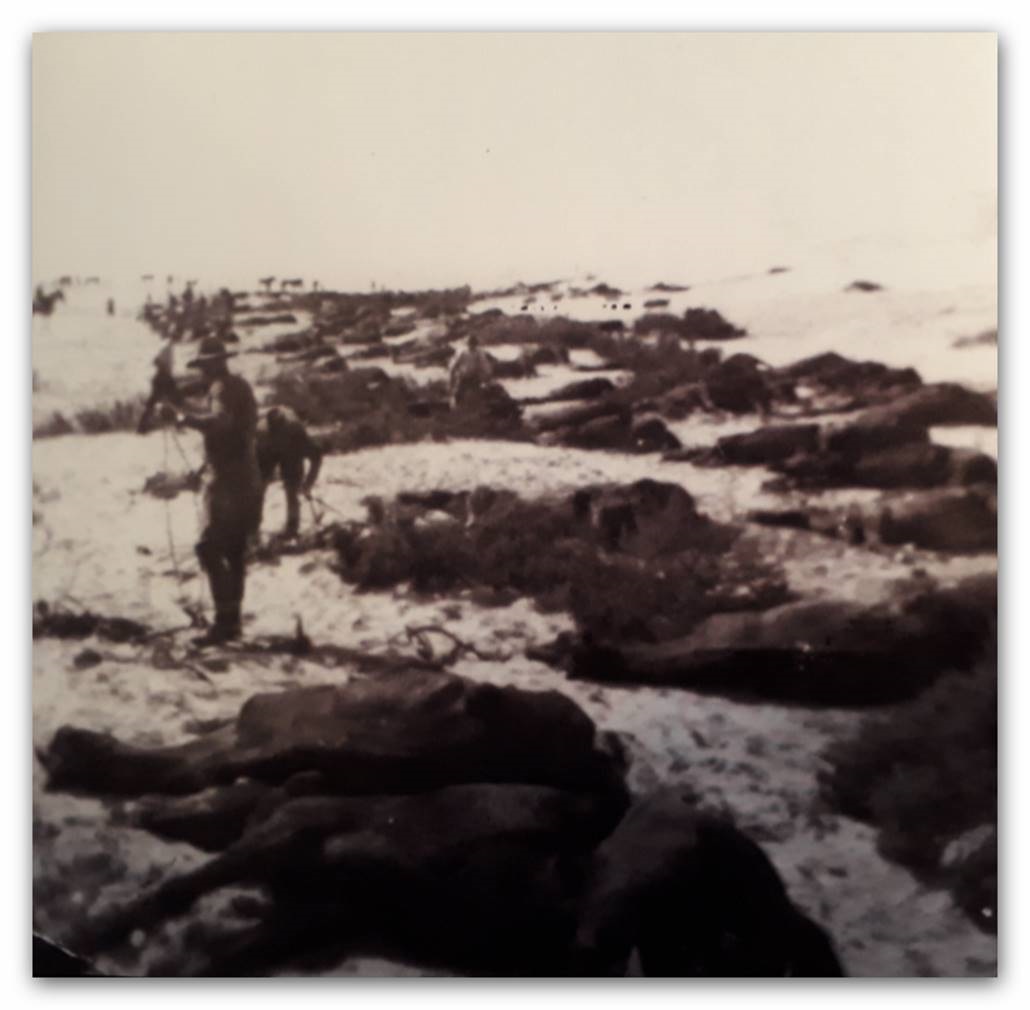
The ANZAC’s transported approx.
136,000 horses to the Middle East. After the war approx. 22,000
were sold and the rest were
casualties of the war, or were shot. (New Zealand had sent 12,000)
These are the photos depicting the dreadful slaughter of their
horses. The strict quarantine and after seeing how the locals treated their horses, camels
and mules the men did not want to leave the beloved horses with them.
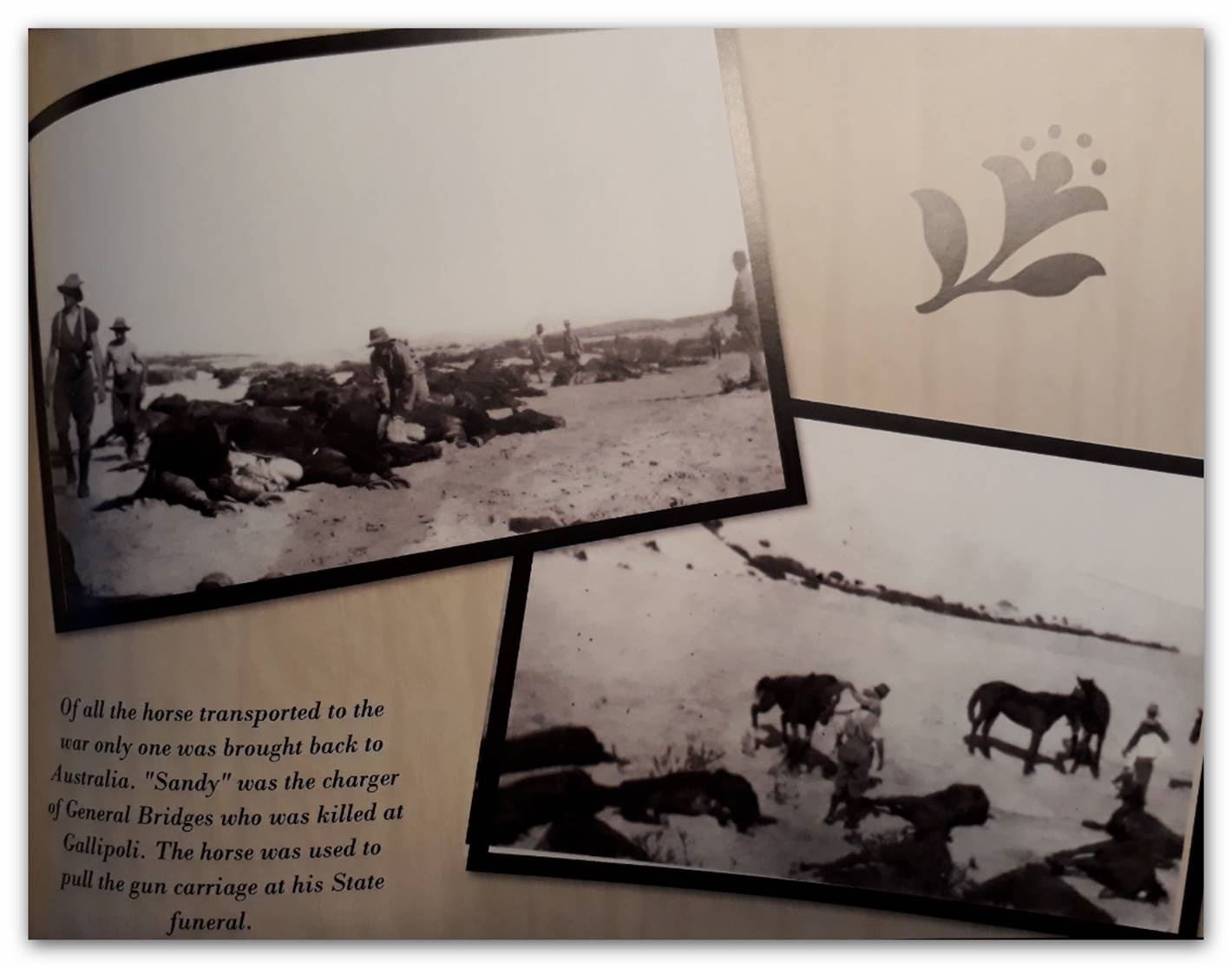
Originally thought to be the
only one horse came back to New Zealand – “Bess”
http://www.stuff.co.nz/national/last-post-first-light/8577109/Bess-came-back
- The moving story of the only horse that came back to New Zealand ("Brave
Bess" - book by Susan Brooker)
Acquiring horses for war
Sinai and Palestine
http://www.nzmr.org/books.htm
The total population of New Zealand in 1914 was just over
1 million
. In all,
120,000
New Zealanders enlisted, of whom
103,000
or 10 per cent of the Kiwi population served
overseas. A total of 18,500 New Zealanders died in or because of the war, and almost 50,000 more
were wounded
http://www.stuff.co.nz/southland-times/news/features/southerners-at-war/2361730/A-nation-born
http://www.aucklandmuseum.com/war-memorial/online-cenotaph/record/C68210
What proportion of the New Zealand population served in the NZEF?
Calculating the proportion of New Zealanders who served in the NZEF depends, as with much else, on
who you include and which figures you select.
Provision and maintenance (Graph 1) plots
embarkation figures as a percentage of the total population, and concludes that 9.2% of the
population embarked on active service. The cited population figure – 1,089,825 – is the government
statistician’s estimate for 31 March 1914, while the active service figure – 100,444 – includes the
naval and aviation recruits who left New Zealand for service in British forces. [22] If you use the figure of 98,950, then 9.1% of the
population left New Zealand on active service.
How many New Zealanders died in each theatre of war?
The
Roll of honour (1924) assigns the 16,697
deaths on active service between August 1914 and November 1918 to four theatres of war plus ‘United
Kingdom and other places and at sea’. Gallipoli claimed 2721 lives (16.3%), while 12,483 (74.8%)
died in France and Belgium, 381 (2.3%) in Palestine, 259 (1.6%) in Egypt and 853 (5.1%) in the
United Kingdom and other places.
Another phase of Alex life began -
Notice:
MARRIAGES (Otago Daily Times 4-12-1919)
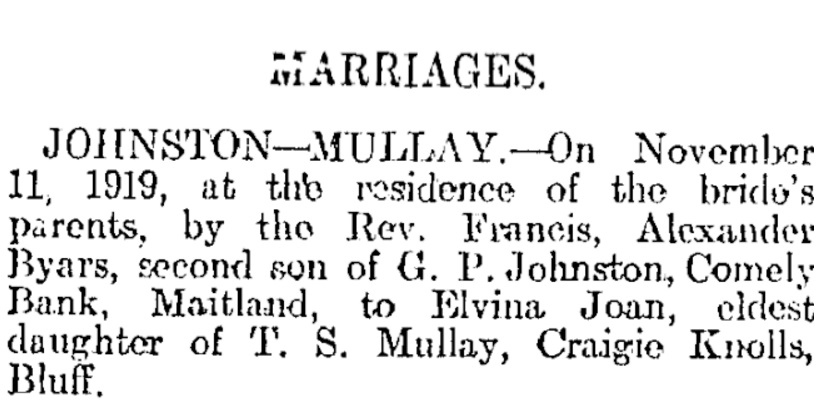
Alex and Elvina farmed at Brydone Southland then Comely Bank
Maitland (Familys origonal Farm)
Children:
Alexander
Ernest
Joan
ALBERT GEORGE JOHNSTON ANZAC
ANDREW MARCHBANK JOHNSTON ANZAC
|

